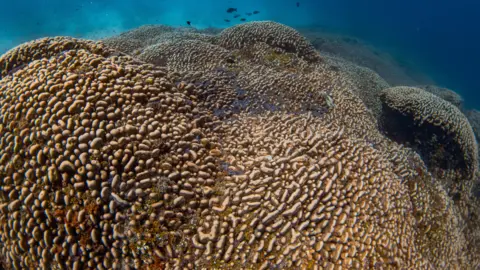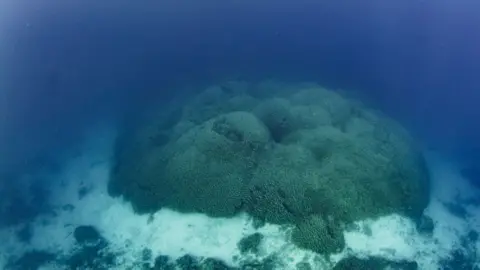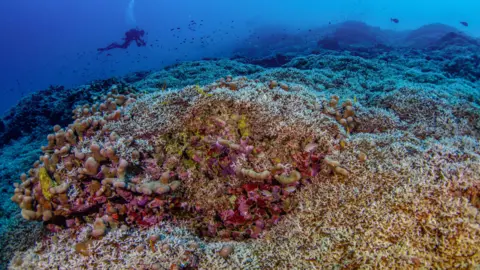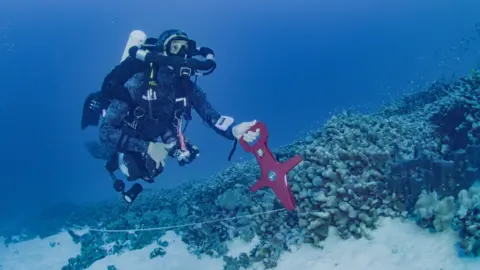
 Photograph by Manu San Félix, National Geographic Pristine Seas
Photograph by Manu San Félix, National Geographic Pristine Seas
Local people had no idea the coral was there
The largest coral ever recorded has been found by scientists in the southwest Pacific Ocean.
The mega coral - which is a collection of many connected, tiny creatures that together form one organism rather than a reef - could be more than 300 years old.
It is bigger than a blue whale, the team say.
It was found by a videographer working on a National Geographic ship visiting remote parts of the Pacific to see how it has been affected by climate change.

 Manu San Felix, National Geographic Pristine Seas
Manu San Felix, National Geographic Pristine Seas
The coral measures 34 metres wide
“I went diving in a place where the map said there was a shipwreck and then I saw something,” said Manu San Felix.
He called over his diving buddy, who is also his son Inigo, and they dived further down to inspect it.
Seeing the coral, which is in the Solomon Islands, was like seeing a "cathedral underwater", he said.
"It's very emotional. I felt this huge respect for something that's stayed in one place and survived for hundreds of years," he said.
"I thought, 'Wow, this was here when Napoleon was alive'," he added.
Scientists on the expedition measured the coral using a type of tape measure under water. It is 34m wide, 32m long and 5.5m high.
Globally coral is facing severe pressures as oceans warm with climate change.
Often described as an “architect” of the seas, corals can join together to form vast reefs where fish and other species live.
Coral reefs also underpin the livelihoods of one billion people including by supporting tourism or fishing, according to the World Economic Forum.

 Manu San Felix, National Geographic Pristine Seas
Manu San Felix, National Geographic Pristine Seas
Scientists say the newly discovered coral is in good health
This specimen was found in deeper waters than some coral reefs, which may have protected it from higher temperatures at the sea surface.
The discovery was announced at the same time as the UN climate talks COP29 in Baku, Azerbaijan that are trying to make progress in tackling climate change.
Mr Trevor Manemahaga, climate minister for the Solomon Islands at the summit, told BBC News that his nation would be proud of the newly-found coral.
"We want the world to know that this is a special place and it needs to be protected," he said.
"We rely mostly on marine resources for economic survival so coral is very, very important [...] And it's very crucial and critical for our economy to make sure our coral is not exploited," he said.
Small island nations like the Solomon Islands are extremely vulnerable to climate change.
Mr Manemahaga said he’s seen first-hand the effects of global warming on his nation, as it causes more powerful cyclones and erodes the coastline causing homes to fall into the water.

 photograph by Manu San Félix, National Geographic Pristine Seas
photograph by Manu San Félix, National Geographic Pristine Seas
Scientists calculated the age of the coral by measuring its growth
Many developing countries at the talks are calling for more cash from richer nations to help them pay for their strategies to tackle climate change.
Mr Manemahaga said that more finance for the Solomon Islands would help the country create more varied jobs that would mean fewer people worked in industries that damage coral reefs.
Currently logging is a major part of the country's economy - between 50-70% of the country's annual export revenue - but it cauuses high levels of water pollution that damages coral in the area.
Eric Brown, who is a coral scientist on the National Geographic research trip, says that the health of the coral was "looking pretty good".
“While the nearby shallow reefs were degraded due to warmer seas, witnessing this large healthy coral oasis in slightly deeper waters is a beacon of hope," he said.
The coral is a species called Pavona clavus and provides a home to shrimp, crabs, fish and other marine creatures.
The age of the specimen also means it acts like a window into the history into oceanic conditions in the past. Scientists hope to study it to learn more about how it has grown.
A report this week found that 44% of corals living in warm waters are threatened with extinction, according to the International Union for the Conservation of Nature. That is an increase of a third since the species were last assessed in 2008.

 1 month ago
5
1 month ago
5















 English (US) ·
English (US) ·